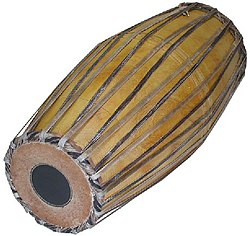 Mridangam Sruthi-Maatha Layam-Pitha Thaalam-Guru
Mridangam Sruthi-Maatha Layam-Pitha Thaalam-Guru
Mridangam is an important 'Percussion Instrument' used in all forms of Carnatic Music concerts, the widely known 'South Indian Classical Music'. The South Indian percussion instrument MRIDANGAM became internationally acclaimed global percussion instrument.. Mridangam (also spelled as Mridhangam. Alternate spellings are, mridanga, mrudangam, mrdangam, mrdangam mrithangam, miruthangam and mirudhangam) makes a concert complete with soothing rhythm enhancing the overall concert with a unique naadham called "Chaapu". Naadham is the term for sound (musical notes) that has the quality of sruthi and pleasant musical vibration in it.(This definition is by Sriram Venkataraman © Copyright 2007-2014). Chaapu naadham, Meetu naadham and Thoppi must be tuned in such a manner that produces an excellent sound. Chaapu Naadham and Meetu naadham must be in the same pitch (that is, in the same note). Thoppi naadham can either be equal to Chaapu naadham or one octave less than that of chaapu naadham. Tuning is itself an art, then comes playing the instrument with an ecstatic sound. Playing the instrument with perfect fingering technique is a must for a mridangist in order to produce proper nadham. Sound interesting isn't it?
How to tune a mridangam?
Tuning is an art that can be mastered by a systematic practice in steps mentioned below:
Maintain the mridangam by repairing it to the best condition with the help of a good repairer. Things required for tuning:
Chromatic Pitch Pipe, small stone, small wooden Stick called"pullu" (made to a size similar to an adult Index finger). Now follow the steps mentioned below:
1. Play the pitch pipe after selecting the pitch needed while simultaneously playing the chapu on the mridangam.
2. Now compare if it matches with the pitch pipe.
3. If the pitch of the mridangam is less, then hold the wooden stick on that particular point on the mootu (between the leather straps) and beat it on the top of the stick with the stone.
4. If the pitch is higher, hold the wooden stick at the bottom of the mootu (between the leather straps) and beat it with the stone from below upwards on the stick.
5. Repeat the process on all sides of the karanai till the pitch matches with the pitch pipe.
6. Matching "meetu naadham" and "Chaapu naadham" requires another step in the tuning process, explained below in the topic "How to match Meetu and Chaapu?" One can use Harmonium or Electronic Tambura or Electronic Sruthi Box, instead of pitch pipe. One can gradually gain 'Sruthi Jnana' by experience so as to accurately tune the mridangam.
How to match Meetu and Chaapu?
Matching meetu and chaapu requires a step that involves the adjustment of "Black Patch" (so called "Soru" or "Saadham"). When meetu is less than chaapu, a small portion of "soru" has to be removed from the center. To do this, twist small piece of cloth like a thick thread and wet it, so that the cloth is just moist enough to be applied circularly on the center of the "soru" to a diameter of around 1 to 1 ½ cm (circumference 3 to 4 ½ cm). See to it that water does not go deep. Just moisture on the surface of the black patch is enough. Now scrap this portion alone with a small blade so that, the black patch (to a minute/thin) layer is shredded. Repeat the procedure till meetu naadham sounds equal to that of Chaapu naadham.
When the Meetu naadham is higher than chaapu, add small layer of black patch at the center to the size mentioned above. Rub this portion with a polished stone to dry it. Applying this small portion of black patch requires experience. You may want to know more about "Black Patch" by reading the topic "Parts Dimensions of Mridangam" If the black patch (Soru) is applied properly and tuning is done as mentioned above, the Chaapu sound will produce an excellent vibration. Chaapu is the key sound, that differentiates with other percussion instruments. Hence chappu playing techniques must be learnt in an accurate manner from a maestro. Meetu naadham is the sound produced when playing the alphabet "Nam". Chaapu in this context is equal to playing the alphabet "Thin" or "Thim" played using index finger holding ring finger at the end of soru.. Actual "Chaapu" is played using little finger. The lesson "Na Thin Thin Na" is the best example of how it would sound. (Na = Nam). Audio demo is in the 'mridangam classes' page.
How to tune Thoppi?
Tune "thoppi" to the corresponding pitch of "Karanai" as mentioned above. Things needed for tuning thoppi.
1. Wooden Stick "Pullu" as mentioned above.
2. Another wooden stick measuring around 8 inches in length and thickness of around 1 to 1 ½ inches is needed. This stick must be tapered at one end like a scale to a length of around 2 inches from the end. This is also called "Aapu".
If the pitch has to be increased, use "Pullu". This has to be placed between the leather straps on the mootu and beat it with the stone on the stick. Do it on all the sides equally. If the pitch has to be decreased, use "Aapu". Insert the Aapu between the mridangam wood and the third layer of the mootu, on the side view of the mridangam. Now beat it with the stone on the Aapu so that, it moves a little inside the third layer, to the extent that it does not touch the fixed mootu. Then check if the thoppi sounds good on all the sides. Repeat the procedure on the sides that require reducing or increasing the pitch, so that the thoppi sounds equally well on all sides. One has to gain experience to produce "Guna Saptha" in mridangam. This can be achieved by direct training through Mridangam Lessons by a maestro. writed by amal sekhar

No comments:
Post a Comment